| کد مقاله | کد نشریه | سال انتشار | مقاله انگلیسی | نسخه تمام متن |
|---|---|---|---|---|
| 1355651 | 1500471 | 2012 | 13 صفحه PDF | دانلود رایگان |

This review examines the mechanisms propelling cofactor-independent, organic cofactor-dependent and metal-dependent decarboxylase chemistry. Decarboxylation, the removal of carbon dioxide from organic acids, is a fundamentally important reaction in biology. Numerous decarboxylase enzymes serve as key components of aerobic and anaerobic carbohydrate metabolism and amino acid conversion. In the past decade, our knowledge of the mechanisms enabling these crucial decarboxylase reactions has continued to expand and inspire. This review focuses on the organic cofactors biotin, flavin, NAD, pyridoxal 5′-phosphate, pyruvoyl, and thiamin pyrophosphate as catalytic centers. Significant attention is also placed on the metal-dependent decarboxylase mechanisms.
Figure optionsDownload as PowerPoint slideHighlights
► Biological decarboxylation reactions use a wide range of approaches to weaken and cleave the CC bond.
► Both organic and inorganic cofactors are capable of serving as the catalytic center of decaroboxylases.
► Metal ions are found in both O2-dependent and oxidant-independent decarboxylase reactions.
Journal: Bioorganic Chemistry - Volume 43, August 2012, Pages 2–14